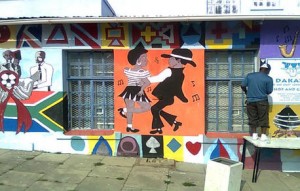G. Wesley Johnson Award: Beyond the shadows
17 April 2015 – Julia Wells
Editor’s Note: This series showcases the winners of the National Council on Public History’s awards for the best new work in the field. Today’s post is by Julia C. Wells, author of “In the Shadow of the Butcher: The Limits to Confronting Colonial Legacies Through Commemoration in South Africa,” The Public Historian Vol 36, No 2. The article won the G. Wesley Johnson Award for the best article published in the journal in the previous year.
First, I wish to express my gratitude and appreciation to all my colleagues at The Public Historian and NCPH who saw fit to honor me with this award. Since it derives from a public project, all the benefits will be ploughed back to help the initiative to keep on growing. At the close of my article, I said that the value of any public history project can by measured by the seeds that it sows for future work. In this short message, I will share the various ways that the 2012 bicentennial commemoration in Grahamstown has stimulated new thinking.
Soon after 2012, a small community of people who shared a passion for putting the past to good use emerged. After working on various projects during 2012, their views and skills were better appreciated all around, making it easy to continue discussing new ideas. A restless energy to do much more began to be felt. An informal discussion group coalesced around the theme of “Re-imagining Grahamstown.” Out of excited exchanges about what ought to still be done, the concept developed of creating an applied history institute at Rhodes University. The name Isikhumbuzo was chosen, meaning “memories” in the Xhosa language. The institute is viewed as being a vehicle for bringing together the best of the academic world with community-based artists to tell and create new histories.
The new institute draws significantly on the lessons learned from the 2012 bicentennial commemorations. For one, it felt that using the university as the driver would reduce the blockages that came from being associated with the government and the expectation of hand-outs. This does not come without its own issues. Since the university has a reputation for doing a good deal of “othering” research in local communities, without giving anything back, the institute expects to eventually be based outside of the university and to work only on projects that are identified from the grassroots.
Another lesson learned from the bicentennial was about the huge potential of using the artistic community of Grahamstown as a driving force for innovation. In recent times, the provincial government of the Eastern Cape has committed to reviving the Dakawa Cultural Center, which now serves as a base for artists working in all genres. It was transplanted from Tanzania, where it had served as an income-generator for the African National Congress when it was in exile, then moved to Grahamstown in 1992 to link up with the creativity of the National Arts Festival. The new management and artistic leadership at Dakawa are extremely enthusiastic about teaming up with the Isikhumbuzo Institute so that all local artists can learn about historical themes to be incorporated into their work.
One of the goals of the Institute is to develop a robust methodology of combining history and art as a way of filling in gaps in historical knowledge. An example used to demonstrate the potential is the story of a young boy who was put on trial in 1819 for attempting to free his mother from forced labour seven years after the war of conquest. The written trial record is very brief, but artists are invited to invent their own interpretations of how the boy and his mother felt. This really sets them all to thinking!
The Isikhumbuzo Applied History Institute will also offer students from Rhodes University a chance to engage with people from the wider community in a way which puts community interests first. While professional historians will share their knowledge on potential topics, themes for focused attention will be agreed on through conversation and dialogue. The Institute aims to tackle one of the needs identified from the bicentennial, which is how to create a healthy balance between “experts” and the wider community. Issues of ownership, participation, and benefits remain central.
A few further sprouting seeds are evident. Plans are now moving forward to use the thirty “Hidden Histories” developed by the museum interns during the bicentennial as the basis for local radio programming. When funds ran out for a printed document, this became an affordable option which is likely to reach a much larger audience.
The Creative City project is moving ahead. It recently hosted a photo-fence and open air movie night at a central playing field, as well as running a concert series of combined school choirs, bringing together all race groups.
Finally, the prize money for winning this award will be used to build a model storytelling fireplace. This was a part of the bicentennial planning but could not be achieved due to a shortage of funds. The plan is to use one-third of the prize for the physical construction, another third for working with local communities on how to use the facility (a group of poets has offered to do this!), and the third portion will be used to develop start-up programs.
Since I am unable to attend the NCPH conference in Nashville, I invite people to chat with me online about their own relevant experiences and thinking. The seeds will keep growing, no doubt.
~ Julie Wells is an Associate Professor of History at Rhodes University in Grahamstown, South Africa. She also serves as a councillor in the local Makana Municipality.




